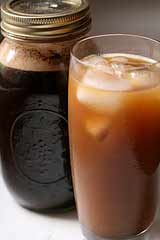Interlude: Diluting Cold Press Coffee
So let's see what the process of "diluting" looks like.
Here's an everyday example:
 Cold Press coffee is a superstrong form coffee made without heating the water. The brew starts out with about a zillion molecules of caffeine per cup. In order to actually be able to drink the stuff, you have to dilute it. For example, you could put one cup of cold press coffee into a pot and add 4 cups of water.
Cold Press coffee is a superstrong form coffee made without heating the water. The brew starts out with about a zillion molecules of caffeine per cup. In order to actually be able to drink the stuff, you have to dilute it. For example, you could put one cup of cold press coffee into a pot and add 4 cups of water.
How many molecules of caffeine are in the pot?
How many cups of coffee are in the pot ?
If you pour 1 cup from the pot, how many molecules of caffeine will it have?
That would work for a true coffee aficionado, but many of us are less hardy (or more wimpy) so we might want another dilution. Let's take 1/2 cup from the pot, and add 4.5 cup of water to make a wimpy pot.
How many caffeine molecules were in the 1/2 cup?
How many caffeine molecules are in our final (wimpy) pot of coffee?
 The Sunbucks across the street makes a wimpy coffee with exactly 13,000 caffeine molecules in a cup. Assuming they used the same dilution scheme, how many caffeine molecules were 1 cup of the original brew?
The Sunbucks across the street makes a wimpy coffee with exactly 13,000 caffeine molecules in a cup. Assuming they used the same dilution scheme, how many caffeine molecules were 1 cup of the original brew?
Here's the dilution scheme:
1 cup brew + 4 cups water --> 5 cups strong coffee, then
0.5 cup strong coffee + 4.5 cup water --> 5 cups wimpy coffee
Another way of saying this is,
the first time we diluted, we kept 1/5 of the caffeine from the brew
the second time we diluted we kept 1/10th of the caffeine from the strong coffee
1/5th of 1/10th = 1/5*1/10 =1/50.
So, working backwards, the original brew must have contained 50 times as much caffeine, or
50*13,000 = 650,000 molecules caffeine / cup
Copyright University of Maryland, 2007
You may link to this site for educational purposes.
Please do not copy without permission
requests/questions/feedback email: mathbench@umd.edu